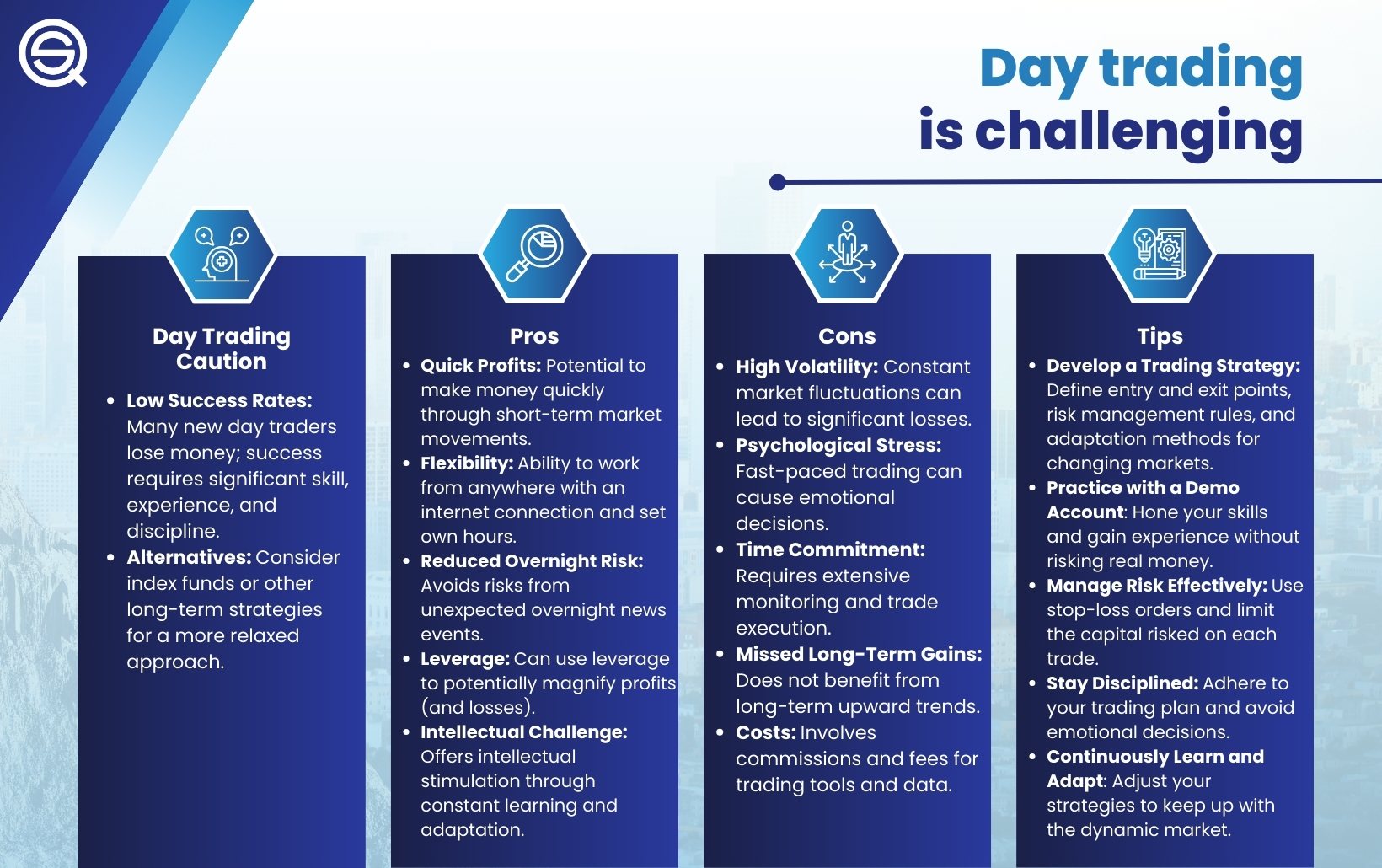Did you know that day traders often joke that they have the attention span of a goldfish—just 9 seconds? In the world of trading, there's a critical distinction between day trading and swing trading that can shape your financial journey. This article dives into the mechanics of both strategies, highlighting how they operate, the time commitment they require, and the tools that traders typically use. It also explores the risks and potential profits associated with each style, providing insights to help beginners decide which approach suits them best. Plus, we touch on the impact of market conditions and tax implications. With the expertise from DayTradingBusiness, you’ll be well-equipped to navigate your trading options effectively.
What is day trading and how does it work?
Day trading involves buying and selling financial instruments within the same trading day, aiming to profit from short-term price movements. Traders execute multiple trades, often leveraging margin to enhance returns.
In contrast, swing trading holds positions over several days or weeks to capitalize on medium-term trends. Day traders focus on quick gains, using technical analysis and real-time data, while swing traders rely more on fundamental analysis and broader market trends.
The primary difference lies in the duration of trades: day trading seeks immediate profits, whereas swing trading allows more time for price fluctuations to unfold.
What is swing trading and how does it work?
Swing trading is a trading strategy that aims to capture short- to medium-term gains in a stock or other financial instrument. Traders hold positions for several days to weeks, taking advantage of price swings. Unlike day trading, where positions are closed within the same day, swing trading involves holding onto trades longer, allowing for more significant price movements. Traders typically use technical analysis to identify trends and entry/exit points, focusing on the momentum of the asset.
What are the key differences between day trading and swing trading?
Day trading involves buying and selling stocks within the same trading day, aiming for quick profits from small price movements. Swing trading, on the other hand, holds positions for days or weeks to capitalize on larger price shifts. Day traders often use technical analysis and execute multiple trades daily, while swing traders rely on both technical and fundamental analysis and make fewer trades. Day trading requires fast decision-making and constant market monitoring, whereas swing trading allows for more time to analyze trends and manage trades.
Which trading style is more suitable for beginners?
Swing trading is more suitable for beginners. It requires less time commitment and allows for greater flexibility, as trades are held for several days to weeks. This gives beginners time to analyze the market and manage their positions without the pressure of making quick decisions every day, as in day trading.
What are the risks involved in day trading?
Day trading risks include high volatility, potential for significant losses, emotional stress, and the impact of transaction fees. Traders face the danger of market manipulation and must constantly monitor their positions, increasing the risk of impulsive decisions. Additionally, leverage can amplify losses, making it crucial to have risk management strategies in place.
What are the risks involved in swing trading?
The risks in swing trading include market volatility, overnight price gaps, and potential for large losses due to holding positions longer than day trading. Traders may face emotional stress from price fluctuations and the risk of news events impacting stock prices while positions are held. Additionally, lack of liquidity can make it harder to exit trades quickly.
How much time do day traders typically spend on trading?

Day traders typically spend 6 to 8 hours a day actively trading. They monitor the markets closely during trading hours, analyzing charts and making quick decisions. This intense focus allows them to capitalize on short-term price movements. In contrast, swing traders may spend only a few hours a week, holding positions for several days to weeks.
How much time do swing traders typically spend on trading?
Swing traders typically spend a few hours each day analyzing charts, monitoring positions, and executing trades. This can range from 1 to 3 hours daily, depending on their strategy and the number of trades they make each week. Unlike day traders, they don't need to be glued to their screens all day, as they hold positions for several days to weeks.
What tools do day traders use for trading?

Day traders typically use tools like trading platforms (e.g., TD Ameritrade, E*TRADE), charting software (e.g., TradingView, MetaTrader), and news aggregators (e.g., Bloomberg, CNBC). They also rely on technical analysis tools, real-time data feeds, and risk management software. Additionally, many use scanners to identify potential trades and mobile apps for on-the-go trading.
What tools do swing traders use for trading?
Swing traders typically use technical analysis tools like charting software, moving averages, and oscillators (e.g., RSI, MACD) to identify entry and exit points. They also rely on platforms that offer real-time data and news feeds to stay informed about market trends. Risk management tools, such as stop-loss orders, are essential for protecting investments. Additionally, swing traders may use trading journals to track performance and refine strategies over time.
How do day trading strategies differ from swing trading strategies?
Day trading strategies focus on making quick trades within a single day, aiming to capitalize on small price movements. Traders typically use technical analysis, charts, and real-time data to execute multiple trades daily. Swing trading strategies, on the other hand, involve holding positions for several days to weeks, targeting larger price swings. Swing traders rely more on fundamental analysis and trends, looking to benefit from price movements over a longer period.
Learn about How to Learn from Day Trading Mistakes
## What Is Day Trading and How Does It Compare to Swing Trading?
Day trading involves buying and selling financial instruments within the same trading day to capitalize on short-term price movements. In contrast, swing trading focuses on holding positions for several days to weeks, aiming to profit from expected price shifts over a longer period. The key difference is the duration of trades: day traders close all positions before market close, while swing traders hold onto them longer.
Learn more about: What is Day Trading?
What are the potential profits from day trading?

Potential profits from day trading can vary widely. Successful day traders can make anywhere from a few hundred to several thousand dollars per day, depending on factors like capital, market conditions, and trading strategies. However, it's also common to incur losses. Unlike swing trading, which focuses on longer-term trends, day trading requires quick decision-making and can yield rapid profits or losses in a single day.
What are the potential profits from swing trading?
Potential profits from swing trading can vary widely based on factors like market conditions, the trader's strategy, and the assets traded. Generally, swing traders aim for gains of 5% to 20% per trade, holding positions for several days to weeks. Successful swing traders can achieve annual returns ranging from 10% to 50%, depending on their skill and market movements. Unlike day trading, swing trading allows for less frequent trades, which can result in reduced transaction costs and less time in front of the screen, but also requires a keen understanding of market trends and timing.
How do market conditions affect day trading and swing trading?
Market conditions significantly impact both day trading and swing trading strategies.
In volatile markets, day traders can capitalize on rapid price movements for quick profits, often executing multiple trades within a single day. Conversely, swing traders benefit from trending markets, holding positions for days or weeks to capture larger price shifts.
In stable markets, day trading may yield fewer opportunities, while swing traders might find more consistent trends to follow. Overall, understanding market conditions helps traders determine the best approach—whether to engage in fast-paced day trading or longer-term swing trading.
Learn about How to Find the Right Market for Day Trading
What are the tax implications of day trading vs. swing trading?
Day trading and swing trading have different tax implications primarily due to the holding periods for assets.
Day trading involves buying and selling securities within the same trading day, often leading to short-term capital gains. These gains are taxed at your ordinary income tax rate, which can be higher than long-term capital gains rates.
Swing trading involves holding positions for several days to weeks. Gains from swing trading are also considered short-term, taxed at ordinary income rates.
If you qualify as a "trader" under IRS rules, you may be eligible for mark-to-market accounting, which can simplify your tax reporting but requires meeting specific criteria.
In summary, both day trading and swing trading typically result in short-term capital gains taxed at your ordinary income rate.
Learn about Tax Implications of Forex Day Trading
How can I choose between day trading and swing trading?
Choose day trading if you prefer short-term gains, have time to monitor the market closely throughout the day, and can handle high volatility. Opt for swing trading if you want to hold positions for days or weeks, have a busy schedule, and prefer a more relaxed approach to trading. Consider your risk tolerance, available time, and trading style to make the best choice.
Learn about How to Choose Stocks for Day Trading Scalping
Conclusion about Day Trading vs. Swing Trading: What’s the Difference?
In summary, both day trading and swing trading offer distinct advantages and challenges, making them suitable for different types of traders. Day trading requires quick decision-making and constant market monitoring, while swing trading allows for more flexibility and a longer-term perspective. Understanding the key differences, risks, and tools associated with each style is crucial for selecting the most appropriate approach for your goals and lifestyle. For personalized insights and further guidance on your trading journey, consider exploring the resources offered by DayTradingBusiness.
Sources:
- A Profitable Day Trading Strategy For The US Equity Market
- Who exacerbates the extreme swings in the Chinese stock market ...
- Investor Perspectives on Trading in the Stock Market as a Source of ...
- Swing Pricing and Fragility in Open-end Mutual Funds, WP/19/227 ...
- Artificial intelligence techniques in financial trading: A systematic ...
- The Relationship between Commodity Prices and Currency ...